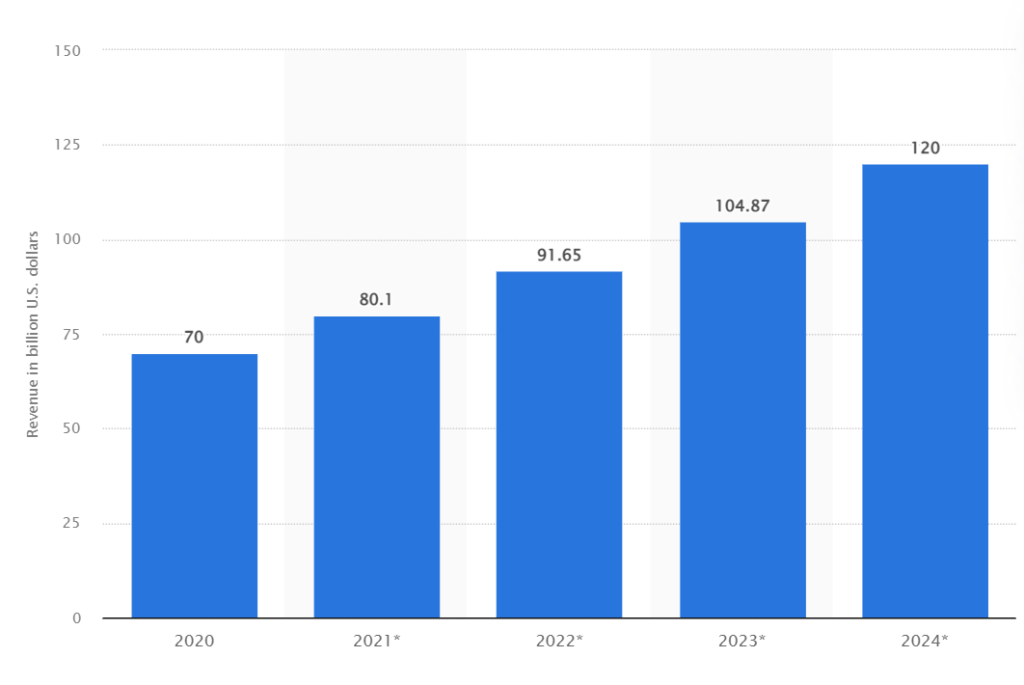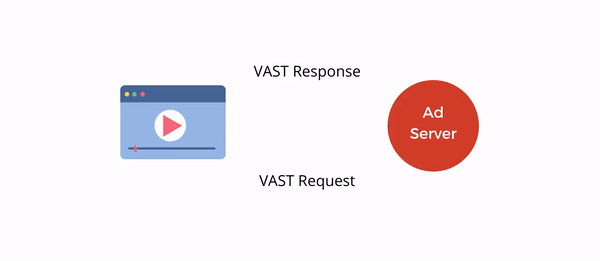Unlock the power of video ad monetization with our comprehensive guide on choosing the best video player. Discover the benefits of customizable players, VAST/VPAID compliance, and much more.
Finding the most suitable video player should be one of the most important parts of a publisher’s strategy for running video ads. Selecting a video player that aligns with a publisher’s requirements can be a challenging task with so many options available.
Additionally, there are other technical factors such as VAST compliance, UI/UX customizations, etc, that publishers should also look at.
In this blog, we will delve into the nitty-gritty details of video ad monetization, but first, let’s understand exactly what it is.
What is Video Ad Monetization?
As the name suggests, video ad monetization is the process where revenue is generated through video ads. There’s no denying that fact that video advertising has now become a major revenue driver for publishers, with global video advertising expenditure expected to reach 120 billion by 2024.
Publishers generally monetize their videos through subscriptions or ads. But in order to make it possible, they require a video monetization platform.

That being said, let’s now shine some light on the importance of video monetization platforms.
Also Read – 7 Video Ads Best Practices to Follow in 2023 – AdPushup
What is The Importance of Video Players?
Publishers often focus on finding the best video ad network and the technicalities of VAST or VPAID. However, the importance of video players is often overlooked.
Video players bridge the gap between the user and the ad. Some ads like in-stream cannot be served without a video player and the user cannot view them without it. That’s how essential their role is.

Next, the video player communicates with the ad server that sends signals in form of a markup language such as VAST. Using VAST or VPAID (the two most common video ad serving templates), a video player is able to read details about the ad creative. And that’s how brands are able to let their ads be seen by the users.
Now that you are well-versed with the video ad monetization platforms and how to single out the best one for your needs, let’s delve deeper and look at the ways publishers can monetize with videos.
How Can Publishers Monetize with Videos?
Here are a few ways publishers can monetize their videos:
Ad-Based Video on Demand
One of the best ways publishers can monetize their content with videos is by AVOD, which refers to ad-based videos on demand. With this method, publishers do not have to charge their audience for content access in order to generate revenue. With AVOD, they can provide their their content to the audience for free while also generating revenue.
Affiliate Deals
Next, publishers can also earn through affiliate deals, which give them a commission or a certain amount of money every time a customer buys a product from their page. For example, a publisher can write a blog on a brand’s product and post the same in their blog with the product’s video and the link. Every time someone buys from that link, publishers make a certain sum of money.
However, to generate consistent income with affiliate marketing, it is important to have a good daily traffic.
Paywall Content
Paywall content is another method of video monetization widely used by publishers across the globe. This method of monetization is also known as the transaction-based video on demand.
Publishers can define a paywall by restricting access to their video or text content. To put it in another way, it requires your audience to pay one-time fees to access the content.
Premium Membership
Subscription-based video on demand (SVOD) is a widely used monetization model for over-the-top (OTT) streaming services. The model allows for recurring membership payments from users, usually on a monthly basis, to access a wide range of content for a specified period.
SVOD provides users with unlimited viewing opportunities during their subscription period. However, once they cancel their subscription, they lose access to the content. It is, therefore, essential for SVOD services to have robust digital rights management (DRM) technology in place to prevent unauthorized access and distribution of content.
Netflix makes a great example of the same where users have to pay for a subscription to watch the movies and series.
Now that you know how to monetize it, let’s understand where you can monetize videos. Here’s a list of the best video players for both medium and large publishers.
Also read – Top 10 Video File Formats for Publishers
Best Video Players for Medium and Large Publishers
1. Brightcove
This is one of the most reliable names in the video advertising industry. Brightcove is a Google video player partner, making the integration with Google Ad Manager quite easy for publishers. Here are some of the distinguishing features of Brightcove:
- Brightcove is quite developer-friendly. This means that using their easily accessible documentation and customizable UI, publishers can deliver video ads according to their preferences.
- Their video player allows server-side/dynamic ad insertion which is also called ad stitching. It means that video ads are inserted into video content based on real-time data generated by the user.
- Brightcove provides video player analytics with actionable insights. Publishers can test videos on different ad placements on the page and the player will report which placement is working well.
- The player is able to support different video serving templates including VAST, VPAID, and VMAP. They also offer an OTT monetization service for mobile, desktop, connected TVs and others.
In addition to these, Brightcove offers a host of other video solutions that can be used to make video ad serving easier. Some of these include Video Marketing Suite, Brightcove Engage, Video Cloud, etc.
Brightcove has three different packages based on publisher team sizes and video needs. These packages include Marketing, Enterprise, and Monetization.
2. Brid.TV
Brid TV is also a Google partner, thus having the same integration advantages as Brightcove.
- Brid.TV’s video player is Google compliant, hence offering the IMA SDK integration without hassle.
- It supports all kinds of video ad formats such as pre-roll, mid-roll, overlay, and others. It is also VAST and VPAID compliant and the tech support offered is quite seamless.
- Brid.TV offers a feature called Async Load which reduces ad load time and makes the player quite lightweight.
- Publishers can customize and tweak the player according to their needs with access to the wide array of resources that Brid offers. Some of these include REACT Component, documentation, Javascript API, etc.
- Some of their additional services are video header bidding, outstream ads, ad reporting and analytics, and others.
Brid.TV offers three plans for publishers including Free, Basic, and Premium.
- The free version allows 250k plays and 150K ad calls.
- The basic version is for $25 a month allowing 500K plays, 250K ad calls, 300GB video streaming per month, and a host of other benefits.
- Premium version trumps all the others because of its customizations based on publisher demands and its pricing is based on publishers’ needs, hence not pre-decided.
3. JW Player
Founded in 2005, JW Player is a very popular name in the video ad-serving market.
- JW Player offers very thorough documentation for publishers to easily integrate the video player on web pages.
- The player makes sure that there are no buffering delays. This is enabled by HLS and DASH adaptive streaming.
- JW Player offers a Video Intelligence solution that has reporting capabilities and analytics for publishers in order to check the performance of their ads.
- Publishers also have access to many other monetization services such as Video Header Bidding, Video Monetization, Yield Optimization, and others.
- JW Player can also be integrated with apps and therefore, is very suitable for a mobile environment.
- Additional features include VAST and VPAID advertising, Google IMA Integration, Advanced Ad Scheduling, and others.
JW Player offers three kinds of packages including Developer, Starter, and Enterprise. The Developer package is free and provides full access to their API. The Starter package is $10 per month and comes with a host of services such as an HTML video player, video gallery, 500GB streaming, 150 GB hosting, etc. For the Enterprise package, custom pricing is available by contacting them.
4. Ooyala
Ooyala is another very popular name in the video ads market. Some of their premium clients include HBO, Fox Sports, etc. They offer a next-generation video player called Player 4 with a robust interface that integrates with multiple platforms.
- They offer two types of video players: Ooyala Skin for iOS and Android, and Ooyala Player 4 for desktop.
- Like other video players, Ooyala has a customizable UX, making publishers’ job easier to customize, integrate, and implement the player on webpages.
- The player has plugins for supporting HLS, DASH, MP4, Live DVR.
- Some of the ad formats supported by the player include pre-, mid-, and post-roll, companion, clickthrough, overlay, skippable, podded, and others. The player also provides server-side ad insertion with Ooyala Pulse.
- Some of the ad integrations supported by Ooyala are FreeWheel, Google IMA SDK, VAST and VPAID Ad Plugin, Adobe Analytics, Google Analytics, comScore, Nielsen Analytics, and others.
For pricing, interested publishers can directly contact Ooyala support.
5. Video.js
Video.js is an open-source HTML5 player that allows publishers to download, customize, and use it without paying any fees. Some of their prominent clients include the Guardian and Funny Or Die.
- Video.js supports all modern video streaming formats, primarily designed for HTML 5 video.
- It allows adaptive streaming which is a video ad serving adjustment according to a user’s internet bandwidth. HLS and DASH are supported everywhere apart from iOS Safari.
- Video.js has the basic capabilities of the video player making it lightweight in nature because of it being open-source. However, community-build plugins can be enabled to customize it as per requirement.
Also Check – The Top 15 Video Ad Networks for Publishers (2023 Update)
Before, singling out a video player, there are certain factors you should take into account, here are a few of them.
How to Choose the Best Video Player?
Video players have undergone massive technological evolution. Initially, they were only meant for playing ads. But now they come with additional features such as providing insights, integration with different ad networks, etc.
However, some of the core principles of finding a suitable video player are still intact.
Here’s how publishers can choose the best video player for them:
Google IMA SDK Integration
If a publisher’s primary ad server is Google Ad Manager, then Google recommends integration with their IMA SDK. This integration allows publishers to display all video ad formats from Ad Manager using API and sending reports from the video player to the server. Hence, a video player that can support this integration should be ideal.
VAST and VPAID Compliance
As mentioned, VAST and VPAID are the two most common ad-serving templates used by video players to communicate with ad servers.
Therefore, it makes sense to choose a VAST/VPAID-compliant player. These IAB templates are responsible for most of the video ads we see on the web nowadays.
Customizable
Most publishers might require UI/UX modifications in video players according to their customer base, website capabilities, etc.
This is why it is essential that the video player, a publisher chooses, is customizable in nature with proper documentation available for tweaking the settings.
Formats
There are a plethora of video ad formats such as pre-roll, overlay, etc., available in the market right now and publishers must make use of as many as possible.
Opting for a video player that offers adoption and implementation of any ad format should be the ideal choice.
Also Read – How to Triple Your Video Ad Revenue: Checklist for Publishers
Advantages of Video Ad Monetization for Publishers
Let’s take a look at a few of the essential advantages of video ad monetization:
Expand your Audience
More and more people are preferring video ads, making them a good source for publishers to generate revenue. Following is the study performed by the eMarketers showing the number of views it is about to attract in 2023 and previous data. Take a look.
One of the significant benefits of video ad monetization is that it helps you maximize your audience base. Most people prefer free content, which is generally ad-monetized rather than paying for it. Since the content will be free to access, publishers can witness an increasing number of views.
Not only this leads to a greater audience, but at the same time, it helps increase the ad revenue. It’s because the ad revenue is directly proportional to the number of views garnered.
Maximizing Revenue
According to Statista, in 2022, total spending on video ads amounted to whopping 75 billion US dollars. This is a significant factor to be taken into account as it implies the effectiveness of video ads. For publishers, this means there’s enormous demand for video ad space they can monetize.
Enhanced User Experience
Video ads can be less intrusive than other ad formats. For example, pre-roll video ads can be skipped after a few seconds, and mid-roll video ads can be placed at natural breaks in the content. This makes video ads less disruptive to the user experience, which can lead to increased engagement and loyalty.
Access to Premium Advertisers
Going with video ads optimization opens more doors for publishers to monetize their content. This can also provide them with access to premium advertisers who may not be interested in other ad formats. Going forward, it helps publishers attract higher-quality advertisers and earn more money per ad impression.
Overall, video ad monetization is a great way for publishers to monetize their content who are not looking forward to going with the paywall or any other method.
In addition to understanding the importance of video players and how to choose the best one for video ad monetization, it’s important for publishers to explore the most effective ways to monetize their videos.
Also Read – Types of Video Ads, Best Practices & How Are They Served
Conclusion
Though we have listed the top five video players present in the market, there are a host of other options available such as Kaltura, DACast, and others. This can be confusing but the key lies in identifying what features publishers require and making a decision based on that.
Some of the features that stand out are speed of ad delivery, plugin support, seamless tech support, customizable solutions, and provision of ad formats. In the end, publishers should always rely on good old ad testing to find the best video ad player.
Looking to maximize your video ad revenue? AdPushup’s ad monetization solutions can help. With our advanced technology and expert support, we can help publishers of all sizes increase their video ad earnings and unlock new revenue streams. Get started today and take your video strategy to the next level. Click here to know more.
Frequently Asked Questions – Video Ad Monetization
You can use video ad platforms like Google AdSense or YouTube Partner Program, and integrate their ad code into your video player. After that, ads will be displayed before, during, or after your video content, and you can earn revenue based on ad impressions or clicks.
There are plenty of video ad types you can display in your videos, including pre-roll ads, mid-roll ads, post-roll ads, and overlay ads. Pre-roll ads are displayed before the video content, mid-roll ads during the video content, post-roll ads after the video content, and overlay ads are displayed as a banner or pop-up over the video content.
The amount you can earn from video ad monetization depends on a number of factors, including:
A) The number of ad impressions or clicks
B) The ad format and placement
C) The ad network you’re using
D) Industry or niche of your video content.
Typically, publishers can earn anywhere from a few cents to several dollars per ad impression or click.

Deepak has a keen eye for detail and a deep understanding of the ad tech landscape. Whether it’s through in-depth articles, thought-provoking insights, or compelling storytelling, he’s dedicated to helping people navigate the complex world of ad tech with the simplicity of his words.







